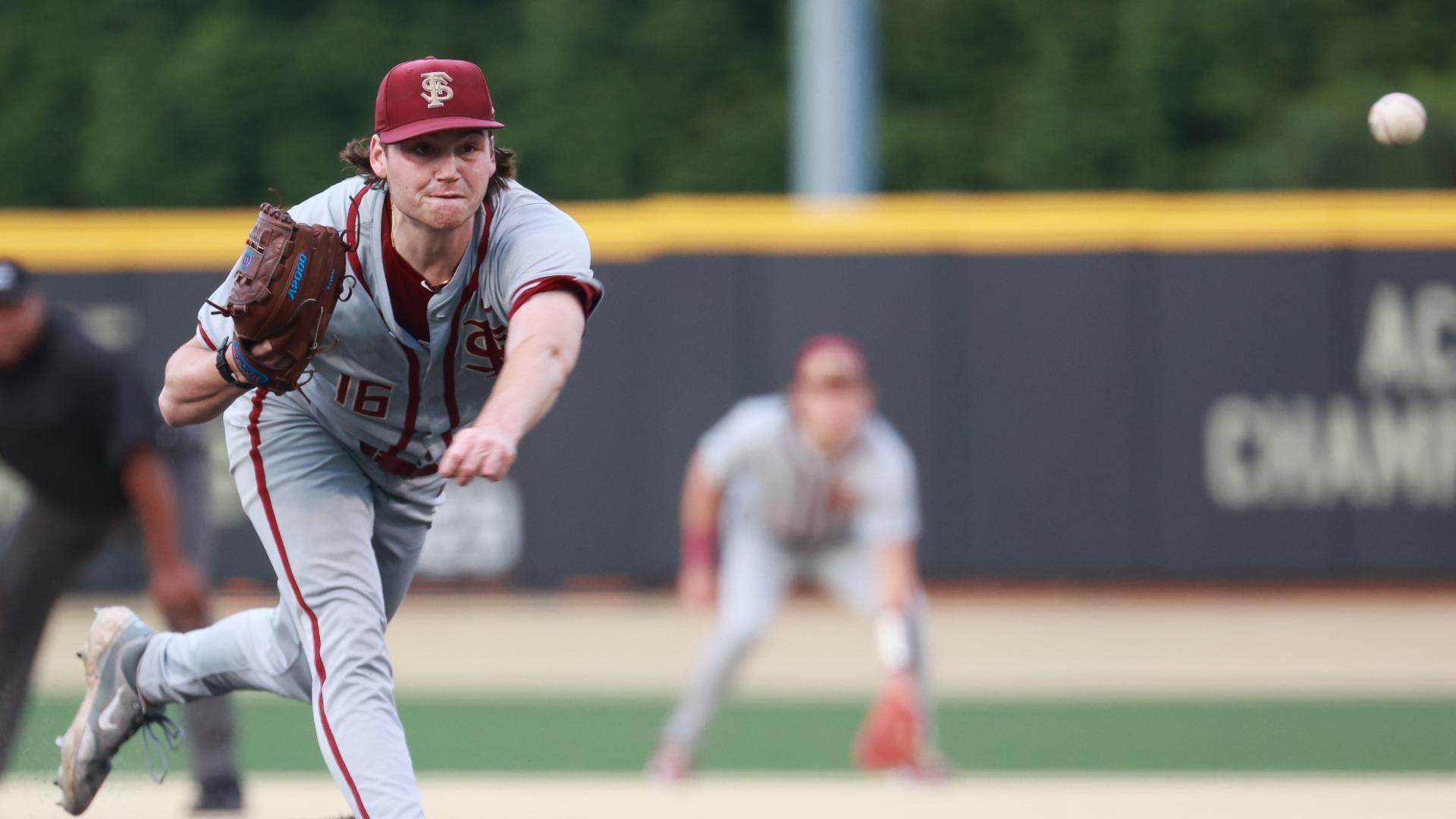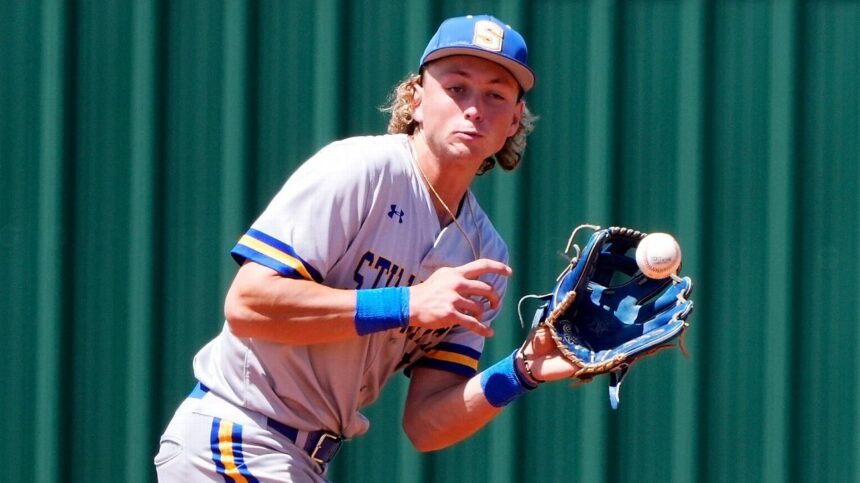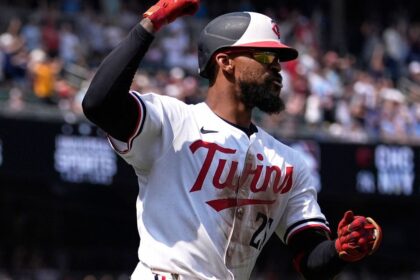As high school seasons wind down across the country and college conference tournaments are about to begin, it’s time for a comprehensive update on how the 2025 MLB draft is shaping up, with a mock mini-draft and a fresh ranking of the top 150 prospects.
As mentioned above, this draft is considered weaker than the 2024 class, and that perception remains. Last year, the final draft ranking included five players with a FV (Future Value) above 50 and 10 total players with an FV of 50 or higher. This year, there are eight players with an FV of 50 or higher and none above that level. We will delve into what this implies below. But first, let’s get to the heart of the matter with a mock draft.
Mini-mock draft: Projections for the first 11 picks
- Washington Nationals: Ethan Holliday, 3B, Stillwater HS (Oklahoma)
This selection is still up in the air. Holliday is considered the most likely option at this time, according to industry conversations. However, Eli Willits and Seth Hernandez are also options, while Jamie Arnold and Liam Doyle are the most likely college options if Washington opts for that route.
These players are very close in the rankings, so the Nationals’ decision in the draft room, along with the price of each prospect, will determine their choice.
- Los Angeles Angels: Jamie Arnold, LHP, Florida State
The Angels are linked to college players who can move up quickly. Arnold, Doyle, and Arquette are the most mentioned, but any of the college players in the top 12 could be the pick with a good performance and the right price.
- Seattle Mariners: Seth Hernandez, RHP, Corona HS (California)
The Mariners are primarily linked to Willits, Hernandez, and Arnold, so they will likely select one of them. Hernandez is considered one of the best right-handed prep pitchers in a long time, but it’s also the riskiest position in the draft due to performance and injury risks.
A weaker draft class top with a rare prospect like Hernandez might be the only time Seattle considers a prep right-handed pitcher so high. The Mariners are paying close attention, and the early positive returns from Ryan Sloan (a prep right-handed pitcher who was their second-round pick) from last year’s draft may also be encouraging them.
- Colorado Rockies: Liam Doyle, LHP, Tennessee
The Nationals and Rockies are widely considered the two most likely destinations for Holliday, meaning he will likely end up here if not selected earlier in the draft day. There is a 75% chance he will be selected first or fourth.
The question is who will be on Colorado’s list if the Rockies don’t get Holliday. Teams selecting in this area have confidently said it will be whoever is available from Doyle/Arnold and shortstop Aiva Arquette.
- St. Louis Cardinals: Kade Anderson, LHP, LSU
The Cardinals historically prefer college left-handed pitchers, and one of the three elite in this class will surely be available here. Like Colorado, I think St. Louis will select Holliday if he arrives (although it seems unlikely given the Rockies’ interest), and their combination beyond that is unclear.
- Pittsburgh Pirates: Billy Carlson, SS, Corona HS (California)
Pittsburgh is believed to be focused on Carlson and Aiva Arquette, with other players also under consideration. Carlson has similarities to Konnor Griffin, the Pirates’ first pick last year, so the belief in the industry is that he is the pick if available.
- Miami Marlins: Eli Willits, SS, Fort Cobb-Broxton HS (Oklahoma)
Willits is in consideration in many of the previous selections, but will likely end up here or in the next selection for Toronto. Miami is believed to be leaning towards hitters with a focus on contact ability, so Carlson, Willits, and JoJo Parker are the most mentioned.
- Toronto Blue Jays: Aiva Arquette, SS, Oregon State
The Jays are waiting to see how the potential chaos unfolds in front of them and to pick up the pieces. In this scenario, it’s Arquette, but his safer player profile means many teams will consider him above this pick. My ranking below has a top tier of eight players, and I’d bet only one or two of those players make it here because that group is pretty consensual within the industry.
- Cincinnati Reds: Jace LaViolette, CF, Texas A&M
Seth Hernandez could end up here because he doesn’t fit for several teams that don’t usually select pitchers, older secondary players, or prep right-handers in high picks. But in this scenario, LaViolette fits the Reds’ history of selecting the best player still available and is the pick.
- Chicago White Sox: Kyson Witherspoon, RHP, Oklahoma
Chicago has been linked to another low-selection left-handed pitcher (Hagen Smith and Blake Larson last year) in high school student Kruz Schoolcraft in this selection, but it feels more like a backup option than the main goal.
The White Sox are at the end of the access to a certain player level in this class, so I think they will react to what is happening above them. Their return from Boston for Garrett Crochet included Braden Montgomery, who was LaViolette’s teammate in the Texas A&M outfield last year, and the rumor is that the current Aggies star has a place here if available.
- Athletics: JoJo Parker, Purvis HS (Mississippi)
Parker’s name was whispered in early spring as the fourth-best prep position player in this class, at a time when he was perceived as a late first-round talent for most teams. That conversation has grown louder to the point that he is now considered the top-ranked prep hitter, who should be selected somewhere between No. 5 and No. 15 on draft day. I believe the A’s will pick him here if he’s available, as he fits their profile.
Here’s where I’ll cut the mock draft, as the consensus top-tier talents are gone and there are a dozen players starting to come into play in the upcoming picks.
I mentioned earlier that the top of this draft is considered weaker, although the depth is considered strong. What this functionally means, in my opinion, is not that this draft as a whole is bad, because it is made up of thousands of players and the classes do not vary that much from year to year in terms of the number of good players.
A couple of scouts have mentioned the 2016 draft as a comparison. At the time, the top of the draft was also considered weaker (Mickey Moniak, Nick Senzel, Ian Anderson were the top three picks) and so it has turned out, but the later rounds were so loaded in retrospect that, if those players were evaluated correctly given what we know now and were selected in the top ten picks, that draft would be considered one of the best of recent times.
Wondering who those stars were later in the 2016 draft? In the first 29 picks, the best player was Josh Lowe, A.J. Puk or Gavin Lux. But after that? Cole Ragans and Will Smith were selected in the 30s, Pete Alonso and Bo Bichette were selected in the 60s and then the parade of sleepers was between picks 83-122: Sean Murphy, Jesús Luzardo, Dustin May, Zac Gallen, Corbin Burnes and Shane Bieber.
I wouldn’t expect that level of impact at the end of this draft, but we could see something similar, as many of those potential stars will be selected later and are ranked somewhere below now that I’ve expanded it to 150.
I classify players using the FV system so you can see where they would rank on your team’s prospect list or a complete MLB top 100 (more details on the scale are included in that link). The 50 FV level generally goes from around 45 to approximately 120 on the overall professional prospect list.
Top 150 MLB Draft Prospects
Level 50 FV
- Jamie Arnold (21.2), LHP, Florida State
Arnold has three above-average pitches a plus from a low arm slot on his fastball, sweeper, and recently improved changeup. He has added a shorter breaking ball similar to a cutter and has two shapes for his fastball, completing his arsenal.
That was the main concern at this time last year, when he was primarily just throwing a fastball and a sweeper that moved so much that he had trouble keeping them in the zone with regularity. The movement that creates his low slot is part of what makes his control (throwing it in the strike zone) better than his command (hitting spots), but when his stuff is so lively and the angles work in his favor, that’s workable and also improvable over time.

- Eli Willits (17.6), SS, Fort Cobb-Broxton HS (OK), Oklahoma commit
Willits is, in my opinion, the best of this class of high school players by a narrow margin. He is an advanced hitter with a solid track record who is young for the class and regularly faces SEC competition due to his brother and father being in the Oklahoma program.
He’s also a plus runner and a good shortstop, so the lack of raw power due to his medium-sized frame doesn’t bother me; this type of player is often underrated at this stage. Here’s a video of my look this spring and some longer thoughts on Willits.
- Ethan Holliday (18.3), 3B, Stillwater HS (OK), Oklahoma State commit
Holliday has even better lineage (brother Jackson, father Matt) than Willits and comes with the conventional size and raw left-handed power that teams want to see with top-tier prep position players. He’s a solid defender who should be above average defensively at third base, but lacks the range/speed to stick at shortstop in pro baseball.
The main concerns here are that Holliday’s summer performances have been regular and he didn’t face much elite velocity this spring, so he could be a .240 hitter going forward. The rest of the profile is not in dispute, so he could actually be a .240 hitter and still be a very good Major League player. Here’s a spring video I took and longer thoughts.
- Seth Hernandez (19.0), RHP, Corona HS (CA), Vanderbilt commit
Right-handed relief pitchers are the worst player demographic in the draft and some teams approach it with extreme caution; some have told me they won’t select a right-handed relief pitcher in the top 10 picks under any circumstances. Some teams who believe that are picking in the top 10 this year.
I also feel strongly about right-handed setup pitchers in general, but for Hernandez specifically, that we might be looking at an exception. His measurable athleticism, the outstanding performances of position players, and the elite change of speed point to things that the typical right-handed setup pitcher doesn’t possess. Hernandez brushes three digits in most outings, his curveball is now showing above average, and his change of speed is plus-plus; take a look at what I saw this spring and some longer thoughts.
- Billy Carlson (19.0), SS, Corona HS (CA), Tennessee commit
Hernandez’s high school teammate is how you draw up a prep shortstop prospect: solid performances with the bat, above-average-to-plus bat speed and raw power, a plus defender, an 80-grade arm, and clear, twitchy athleticism across the board (look and read longer thoughts).
Carson will need to moderate his swing mechanics a bit in professional baseball, but the big question for teams is his age. The track record of prep position players of this age (turns 19 just after draft day) suggests, in short, that they tend to be overvalued at the time of the draft because they face exclusively younger competition at a time when age is very important. On the other hand, Carlson resembles Bobby Witt Jr. if his frame and tools were scaled down a bit. In a weaker draft, that upside is very attractive.
- Liam Doyle (21.0), LHP, Tennessee
- Kade Anderson (21.0), LHP, LSU
I will group these two college left-handed pitchers. Both are tearing up the SEC, but they do it very differently. Doyle offers power stuff and intensity on the mound with some reliever risk due to how he goes about it. Anderson has a much more fluid and true starter look with four above-average pitches and above-average command.
Traditionally, scouts prefer the clear-cut starter in this type of situation at the top of a draft, but Doyle’s pitching data and improvement make some teams think he could be a Major League starter in short order, with an impact reliever backup plan, while Anderson will likely take a more conventional path.
- Aiva Arquette (21.7), SS, Oregon State
Arquette is clearly the best college position player, but is generally considered to have a slight contact/focus question and is so big (1.95 meters, 99.8 kg) that most evaluators believe he will shift to third base as a professional.
He has plus raw power and is performing well (albeit against slightly lesser competition), so he’s getting mentioned in top-10 conversations, but he has more in common with Braden Montgomery (No. 12 overall pick last year) or Christian Moore (No. 8 overall pick) than the top college position players who went in the top seven picks of last year’s draft (Jac Caglianone, Nick Kurtz, Charlie Condon and J.J. Wetherholt).
Level 45+ FV
- JoJo Parker (18.8), SS, Purvis HS (MS), Mississippi State commit
Parker is viewed along with Willits as the hitter with the highest probability at the top level of this year’s prep class, which is driving his rise up the board. He has roughly average raw power and speed and can stay in the infield, but is probably not a long-term shortstop. Parker is not considered to have a huge upside, but if within a year he looks like a plus-plus hitter who will hit between 15 and 20 home runs while playing solid second or third base, that concern will seem a bit silly. Here’s a video of my spring look at him.
- Kyson Witherspoon (20.9), RHP, Oklahoma
Witherspoon remade his delivery and is drawing comparisons to Dylan Cease due to his physique, mid-90s velocity, and three breaking ball shapes. He has pared down his arsenal lately to a four-seam fastball, a cutter, and a curveball. There are still some questions about his command and whether he has a true plus second pitch behind his fastball, but on some days both concerns seem misguided.
- Steele Hall (17.9), SS, Hewitt-Trussville HS (AL), Tennessee commit
I’m pretty sure I’ll be the guy who values him the highest in Hall, but I’m fine with that. He’s a plus-plus runner who will stick at shortstop and is somewhere on the Trea Turner/Anthony Volpe/Jett Williams spectrum of smaller shortstops with true speed and true ability to lift the ball to maximize power at a young age. Being among the youngest players in the draft after reclassifying only helps the case here.
- Jace LaViolette (21.6), CF, Texas A&M
Opinions on LaViolette have gone up and down a lot this year, but on the right day scouts see a 6-foot-6 outfielder who can play center field at least for now, has plus-plus raw power and is performing in the SEC. On the other hand, some evaluators see a long-term corner outfielder with long arms that make him offensively streaky and will limit him to being a .240 hitter at best, more in line with an Adam Dunn or Joey Gallo without a peak. Still a good player, but flawed.
Level 45 FV
- Gavin Fien (18.2), 3B, Great Oak HS (CA), Texas commit
- Wehiwa Aloy (21.4), SS, Arkansas
- Marek Houston (21.2), SS, Wake Forest
- Slater de Brun (18.1), CF, Summit HS (OR), Vanderbilt commit
- Kayson Cunningham (19.0), SS, Johnson HS (TX), Texas commit
- Josh Hammond (18.8), 3B, Wesleyan Christian HS (NC), Wake Forest commit
- Xavier Neyens (18.7), 3B, Mount Vernon HS (WA), Oregon State commit
- Daniel Pierce (18.9), SS, Mill Creek HS (GA), Georgia commit
- Gage Wood (21.5), RHP, Arkansas
- Tate Southisene (18.8), SS, Basic HS (NV), USC commit
- Sean Gamble (18.9), 2B, IMG Academy HS (FL), Vanderbilt commit
- Gavin Kilen (21.2), SS, Tennessee
- Ethan Conrad (21.0), RF, Wake Forest
- Ike Irish (21.6), C, Auburn
- Brendan Summerhill (21.7), CF, Arizona
- Tyler Bremner (21.2), RHP, UC Santa Barbara
- Jordan Yost (18.5), SS, Sickles HS (FL), Florida commit
- Luke Stevenson (21.0), C, North Carolina
- Mason Neville (21.5), CF, Oregon
- Cam Appenzeller (18.5), LHP, Glenwood HS (IL), Tennessee commit
- Kruz Schoolcraft (18.2), LHP, Sunset HS (OR), Tennessee commit
- Cam Cannarella (21.8), CF, Clemson
I will stick with the guy who values Fien the most, as I believe in what I saw last summer (above-average hitter to plus, plus power, excellent performances, good chances to stay at third base), despite a difficult spring. Aloy and Houston are the rare true college shortstops, but Aloy has real contact/chase questions, while Houston can resemble Dansby Swanson at times, but his offensive potential is in doubt. Among college hitters, Irish and Neville are on the rise, while Kilen is getting a chance to play shortstop now for the Volunteers.
The real intrigue in this group, as it was during the loaded 2023 draft, are the prep position players, mainly the infielders. There’s probably one or two stars in this group, although I said that for the 2023 draft and there may be more in that group. De Brun has some Corbin Carroll elements to his game, Hammond looks like the Blue Jays version of Josh Donaldson and Cunningham may be the purest hitter in the entire draft and is a plus runner who can play in the infield. Neyens may have the biggest raw power in the entire draft. Pierce is a scout favorite for his athleticism, build, and defense, while Southisene and Gamble have big upside but contact questions.
Level 40+ FV
- Caden Bodine (21.6), C, Coastal Carolina
- Aaron Watson (18.5), RHP, Trinity Christian HS (FL), Virginia commit
- Marcus Phillips (21.0), RHP, Tennessee
- Zach Root (21.4), LHP, Arkansas
- Alex Lodise (21.4), SS, Florida State
- Matthew Fisher (19.3), RHP, Evansville Memorial HS (IN), Indiana commit
- Landon Harmon (18.8), RHP, East Union HS (MS), Mississippi State commit
- Cade Obermueller (22.0), LHP, Iowa
- Patrick Forbes (20.9), RHP, Louisville
- Brock Sell (18.7), CF, Tokay HS (CA), Stanford commit
- Nick Becker (18.6), SS, Don Bosco HS (NJ), Virginia commit
- Riley Quick (21.1), RHP, Alabama
- Alec Blair (18.7), CF, De La Salle HS (CA), Oklahoma commit
- Max Belyeu (21.5), RF, Texas
- Anthony Eyanson (20.8), RHP, LSU
- J.B. Middleton (21.6), RHP, Southern Miss
- Dax Kilby (18.6), SS, Newnan HS (GA), Clemson commit
Watson is the most complete and advanced prep pitcher in the class behind Hernandez. Fisher offers a good mix of polish and stuff, while Harmon offers high-octane stuff with less feel. Phillips has a dubious arm action but extremely lively stuff. Sell is likely not draft-eligible, but basketball [top 100 hoops recruit](https://www.espn.com/college-sports/basketball/recruiting/player/_/id/254965/alec-blair) Blair could be draft-eligible for the right price with some Cody Bellinger vibes to his game. Quick was a four-star offensive tackle recruit in high school and has plus stuff but below-average feel. Eyanson and Middleton are rising college starters, while Kilby could sneak into the 30-40 selections due to a big swing and strong athletic testing.
At the FV 40 level below, keep an eye on low slot lefty Fernsler as a rising prep prospect who could sneak into the top 40 picks.
Level 40 FV
- Charles Davalan (21.6), LF, Arkansas
- Andrew Fischer (21.0), 3B, Tennessee
- Jack Bauer (18.5), LHP, Lincoln Way East HS (IL), Virginia commit
- Jaden Fauske (18.7), RF, Nazareth Academy HS (IL), LSU commit
- Uli Fernsler (17.9), LHP, Novi HS (MI), TCU commit
- Devin Taylor (21.5), LF, Indiana
- Mason Pike (18.9), RHP/SS, Puyallup HS (WA), Oregon State commit
- J.D. Thompson (21.8), LHP, Vanderbilt
- Korbyn Dickerson (21.7), CF, Indiana
- Taitn Gray (17.8), C, Grimes Community HS (IA), Oregon commit
- Angel Cervantes (17.8), RHP, Warren HS (CA), UCLA commit
- Ethan Petry (21.0), 1B, South Carolina
- Dean Curley (21.1), 3B, Tennessee
- Daniel Dickinson (21.5), 2B, LSU
- Mitch Voit (20.9), 2B, Michigan
- Drew Faurot (21.7), 2B, Florida State









